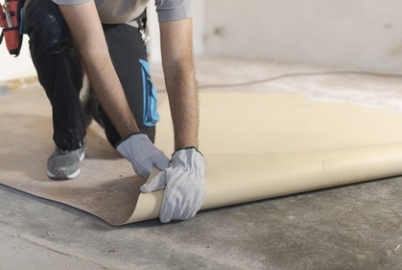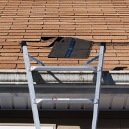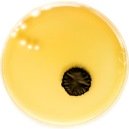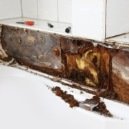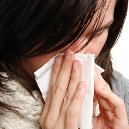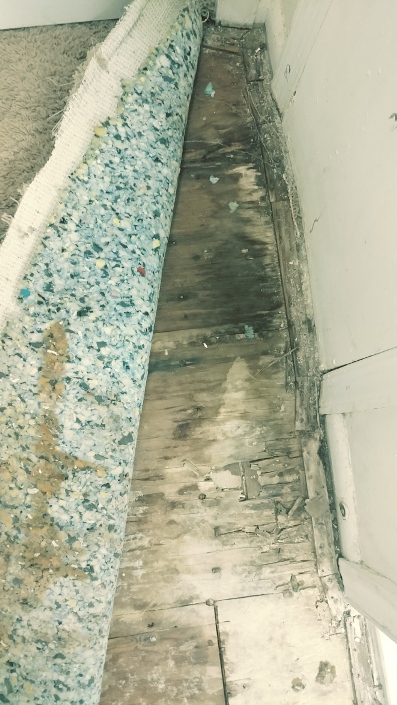Find a pre-screened local mold removal specialist Free Estimate
Find a Mold Specialist Now
Click or Call, Toll-Free 24/7
Subfloor Mold
A subfloor is the layer or layers of flooring located under the finish floor covering. The finish flooring may be carpet and pad, hardwood, laminate, vinyl, or ceramic tile. Subfloors usually represent the primary, or first, layer that is installed directly on top of floor joists. At times subfloors are made of more than one layer, especially if there is a vinyl tile or sheet vinyl being used as the finish floor covering. In that case a secondary layer, or underlayment is used on top of the primary layer to provide a smooth and consistent surface on which to install the vinyl. Most subfloors are made of plywood or OSB (oriented strand board), a type of engineered wood.
I have, however, also seen mold under finish flooring when there is a concrete subfloor present. Although mold will not grow on inorganic materials like concrete, it can grow on any organic adhesive materials used to glue down the finish flooring, as well as any organic materials like dirt and dust that may be present.
Why Does Subfloor Mold Develop?
Subfloor mold usually develops due to an undetected moisture intrusion between the different layers of flooring, especially when the finish flooring is sheet vinyl, laminate flooring, or ceramic tile. I say especially only because if your flooring is carpet, the moisture is much more apparent and quickly and easily discovered.
Unwanted moisture can originate from many different sources such as a slow supply line leak on a faucet or toilet. Another common, and usually harder to determine source of excess subfloor moisture, is a faulty wax ring seal under a toilet that allows water to “escape” from drainpipes and affect the subflooring. Anytime you have warm temperatures (we all like our houses nice and warm), a source of water, and organic food materials like plywood or OSB, it is possible for mold to develop.
Mold Health Risks
Mold exists everywhere in nature, even inside of your home. If mold didn’t exist, the world would be knee deep in dead foliage and dinosaurs. As long as the types and amounts of mold present mirror what can be found in your outside environment, you really do not have a “problem”. That said any mold growth that is visible to the naked eye should be considered a possible health risk. When mold colonies reproduce, or they are “attacked” by a different type of mold colony, or by human remediation procedures, mold spores and mycotoxins (chemicals that are commonly present on spores) can be released into the air. These can be inhaled by the home’s occupants. The inhalation of mold spores is the cause of most allergic reactions in people that have a sensitivity to mold.
How Do You Know If Subfloor Mold Is Present?
When mold grows on your subfloor it can be very difficult to find. Since it is under your finished flooring, you usually cannot see it. You may however smell it. Most molds produce a musty, pungent, earthy odor. Sometimes a mold-sensitive person will suffer from allergic symptoms when exposed by just spending time in a room containing mold.
How To Find Hidden Subfloor Mold
Even if you have access to professional moisture detection meters, subfloor mold can be difficult to discover. Perhaps the easiest means of detecting a subfloor mold problem are seeing discoloration on vinyl flooring, warping or distortion in areas of flooring, or the presence of malodors.
Because many vinyl sheet materials have an organic paper backing, they are subject to mold growth. Mold will not grow on the vinyl, but the paper backing is an organic food source in this case. At times this mold growth causes a discoloration to the vinyl’s surface that can be seen by the homeowner.
As plywood and OSB wood products absorb moisture, their layers can separate or warp. Although this is not a guarantee that there is mold present, it is an indication of a potential problem area that requires further inspection.
The best way to determine whether a mold problem exists on a subfloor is to remove the finish flooring material. If the finish floor is carpet and pad, it can be easily disengaged and rolled back to expose the subfloor material. When vinyl tiles or vinyl sheeting is the finish flooring, it usually requires cutting a small piece of the vinyl out to see what lies underneath. (Remember that an additional subfloor layer, or underlayment, will usually be present and the mold problem may still be hidden between the underlay and the primary subfloor.) When the flooring is hardwood or laminate, it may be possible to remove a small area to inspect beneath it, and then the hardwood or laminate can be reinstalled without doing permanent damage to the flooring.
If your home has a basement or a crawlspace, there is always the chance that by inspecting the underside of the subfloor from below you may see any existing mold. But again, this is no guarantee of a lack of mold presence on the topside of the subfloor.
Subfloor Mold Removal
If an inspection reveals the presence of mold, the inspection site should be covered with plastic and sealed with painter’s or packing tape until the remediation process is begun. This is important because even gentle air movement across the surface of the mold can disturb and spread mold spores. Removal of any mold, especially subfloor mold, is a complicated procedure. During any mold removal, there is the danger of spreading the mold spores throughout any unaffected areas of the home. A remediation plan should be designed and adequate containment of the affected areas must be in place BEFORE beginning any removal. A negative air machine, or air scrubber, should be in operation to help “scrub” any displaced mold spores from the air to prevent cross-contamination. Proper personal protection equipment (PPE, gloves, masks/respirators, clothing, etc.) should also be worn when dealing with any mold infestation.
Porous materials that have come into contact and may be contaminated by mold should be removed and properly discarded. Mold on porous materials should never be “cleaned” or covered up. Mold will not survive without water, but mold spores will. If any water is reintroduced in the future, the mold spores will regenerate and your mold problem will return.
Just Bleach It?
Contrary to popular belief, bleach will not kill mold on porous surfaces. In fact, chlorine bleach is about 95% water. Only 5% is actual chlorine and chlorine is a disinfectant, not an effective killer when it comes to mold. When you apply chlorine bleach to wood, a porous material, the 95% of the bleach that is water will be absorbed into the wood. You have essentially watered your mold problem. Bleach is made up of water and the chemical chlorine. Chlorine is scientifically designed NOT to penetrate porous materials. It will affect a surface it is applied on, but it will not be absorbed. People using bleach to remove mold only remove the surface mold. The mold that exists below the surface of a material is not affected by an application of bleach.
Chlorine bleach will kill mold that is on a non-porous surface, like glass, countertops, and ceramic tile. If you decide to use bleach, understand that the vapors can be dangerous. Bleach is also a powerful irritant to your skin so you should always wear protective gloves when handling it. In addition, the U.S. Environmental Protection Agency (EPA) does not recommend that you use chlorine bleach to kill or remove mold from porous surfaces. And just killing the surface mold is not the solution to your problem, the mold needs to be first contained and then removed.
Subfloor mold removal is best left to a professional remediation company. They have the tools necessary to locate and remediate every affected area. For a list of mold remediation experts in your area, just follow the link.
Return From Subfloor Mold To Our Main Remediation Page
Written by Mark Huey.
Free Home Inspection By A Mold Removal Specialist
Search This Website
Recent Articles
-
See Our 5 Recommended Mold Removal Companies in Covington, KY
Apr 16, 25 12:59 PM
-
See Our 5 Recommended Mold Removal Companies in Wheaton, IL
Jun 20, 24 10:33 AM
-
See Our 5 Recommended Mold Removal Companies in Aberdeen, SD
Oct 08, 21 04:05 PM
